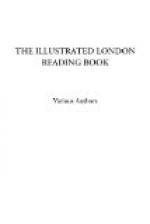When Washington Irving visited Stratford-upon-Avon, he was led to make the following elegant reflections on the return of the poet to his early home:—“He who has sought renown about the world, and has reaped a full harvest of worldly favours, will find, after all, that there is no love, no admiration, no applause, so sweet to the soul as that which springs up in his native place. It is there that he seeks to be gathered in peace and honour among his kindred and his early friends. And when the weary heart and failing head begin to warn him that the evening of life is drawing on, he turns as fondly as does the infant to the mother’s arms, to sink in sleep in the bosom of the scene of his childhood. How would it have cheered the spirit of the youthful bard, when, wandering forth in disgrace upon a doubtful world, he cast a heavy look upon his pastoral home, could he have foreseen that, before many years, he should return to it covered with renown; that his name should become the boast and glory of his native place; that his ashes should be religiously guarded as its most precious treasure; and that its lessening spire, on which his eyes were fixed in tearful contemplation, should one day become the beacon, towering amidst the gentle landscape, to guide the literary pilgrim of every nation to his tomb!”
The accredited birth-place of Shakspeare has always been regarded with great interest: it is situate in a street in Stratford, retaining its ancient name of Henley, being the road to Henley-in-Arden. In 1574, here stood two houses, with a garden and orchard attached to each; and these houses were then purchased by John Shakspeare, whose son William was born in one of them, which still remains, though altered according to modern fashion. Its gable roofs are destroyed. Divided and subdivided into smaller tenements, part was converted into a little inn; part, the residence of a female who formerly showed the room where Shakspeare first saw the light, and the low-roofed kitchen where his mother taught him to read. The walls of the room in which he was born are literally covered with thousands of names, inscribed in homage by pilgrims from every region where the glory of Shakspeare is known. At the time when Shakspeare’s father bought this house, it was, no doubt, quite a mansion, as compared with the majority of the houses in Stratford; but he little guessed the fame that would attach itself to this birth-place of his gifted son; long, we trust, to be preserved for the gratification of future generations of visitors to the hallowed spot. Besides his plays, Shakspeare was the author of several other poetical productions, and especially of a collection of sonnets.
[Illustration: SHAKSPEARE’S HOUSE, STRATFORD-UPON-AVON.]
* * * * *
THE RETURN OF THE DOVE.
[Illustration]




